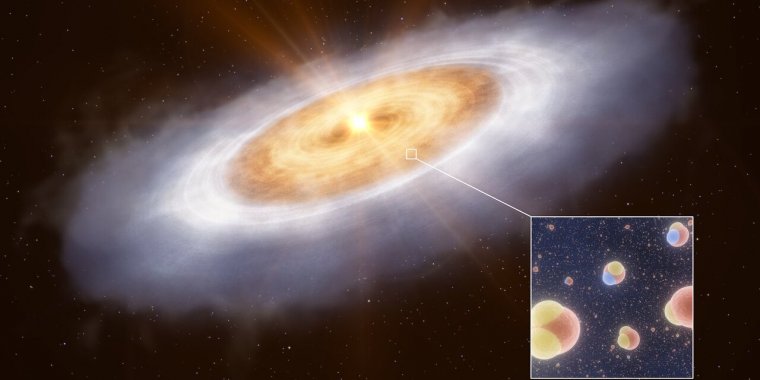| News / Space News |
Astronomers find missing link for water in the Solar System
Using the Atacama Large Millimeter/submillimeter Array (ALMA), astronomers have detected gaseous water in the planet-forming disc around the star V883 Orionis. This water carries a chemical signature that explains the journey of water from star-forming gas clouds to planets, and supports the idea that water on Earth is even older than our Sun.

Water in the planet-forming disc around the star V883 Orionis (artist’s impression). Photo: ESO
“We can now trace the origins of water in our Solar System to before the formation of the Sun,” says John J. Tobin, an astronomer at the National Radio Astronomy Observatory, USA and lead author of the study.
This discovery was made by studying the composition of water in V883 Orionis, a planet-forming disc about 1300 light-years away from Earth. When a cloud of gas and dust collapses it forms a star at its centre. Around the star, material from the cloud also forms a disc.
Over the course of a few million years, the matter in the disc clumps together to form comets, asteroids, and eventually planets. Tobin and his team used ALMA, in which the European Southern Observatory (ESO) is a partner, to measure chemical signatures of the water and its path from the star-forming cloud to planets.
Water usually consists of one oxygen atom and two hydrogen atoms. Tobin’s team studied a slightly heavier version of water where one of the hydrogen atoms is replaced with deuterium — a heavy isotope of hydrogen.
Because simple and heavy water form under different conditions, their ratio can be used to trace when and where the water was formed.
For instance, this ratio in some Solar System comets has been shown to be similar to that in water on Earth, suggesting that comets might have delivered water to Earth.
The journey of water from clouds to young stars, and then later from comets to planets has previously been observed, but until now the link between the young stars and comets was missing.
“V883 Orionis is the missing link in this case,” says Tobin. “The composition of the water in the disc is very similar to that of comets in our own Solar System. This is confirmation of the idea that the water in planetary systems formed billions of years ago, before the Sun, in interstellar space, and has been inherited by both comets and Earth, relatively unchanged.”
But observing the water turned out to be tricky. “Most of the water in planet-forming discs is frozen out as ice, so it’s usually hidden from our view,'' says co-author Margot Leemker, a PhD student at Leiden Observatory in the Netherlands.
Gaseous water can be detected thanks to the radiation emitted by molecules as they spin and vibrate, but this is more complicated when the water is frozen, where the motion of molecules is more constrained.
Gaseous water can be found towards the centre of the discs, close to the star, where it’s warmer. However, these close-in regions are hidden by the dust disc itself, and are also too small to be imaged with our telescopes.
Fortunately, the V883 Orionis disc was shown in a recent study to be unusually hot. A dramatic outburst of energy from the star heats the disc, “up to a temperature where water is no longer in the form of ice, but gas, enabling us to detect it,” says Tobin.
The team used ALMA, an array of radio telescopes in northern Chile, to observe the gaseous water in V883 Orionis.
Thanks to its sensitivity and ability to discern small details they were able to both detect the water and determine its composition, as well as map its distribution within the disc. From the observations, they found this disc contains at least 1200 times the amount of water in all Earth’s oceans. (ESO)
YOU MAY ALSO LIKE





